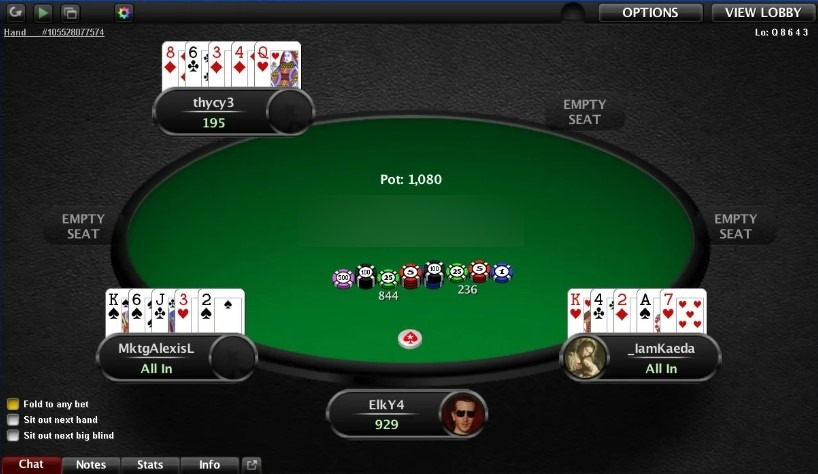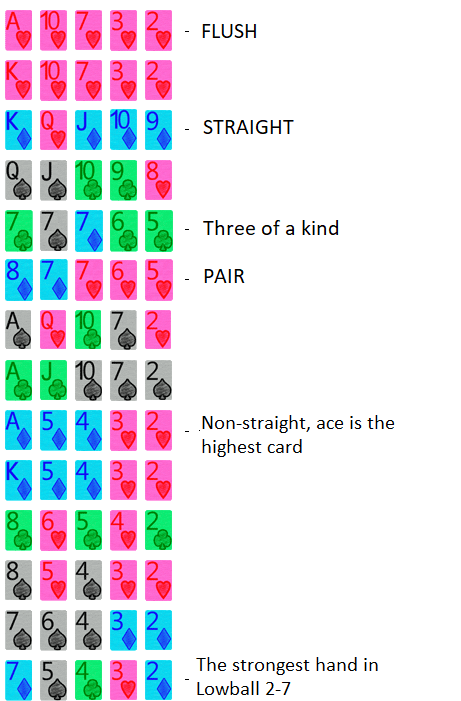2-7 Lowball Poker
Lowball 2-7 with Triple Draw: Rules, Combinations, Strategy
Lowball 2-7 with triple draw (triple draw) is an exciting variation of poker. It is notable for the fact that participants in the game need to collect low-value combinations – only with them is there a chance to win and take the pot.
Game Rules
The game of Lowball 2-7 with triple draw begins with the posting of mandatory bets. Only two participants in the hand make these bets – the players sitting to the left of the button (dealer). One of them posts the big blind, and the other posts the small blind. These bets form the initial pot. At the very start, participants have something to compete for.
At some poker tables for Lowball 2-7, antes may be in play. This is one of the variations of mandatory bets. When antes are in play, all participants contribute to the pot at the start, not just two players. However, the antes are smaller than the big blind, usually no more than 10%.

After placing the mandatory bets, the main game begins. Each participant is dealt five cards face down, which means they are not visible to opponents. After that, the poker player to the left of the big blind initiates a round of betting. During this round, the following actions are available:
- Bet – match the big blind.
- Raise – increase the bet.
- Call – place in the pot the same amount as the previous opponent.
- Re-raise – raise the opponent’s bet by adding even more to the pot.
- Fold – decline to participate in the current hand by discarding the cards.
Participants declare their decisions clockwise. The betting round continues until all remaining players at the table make equal contributions to the pot. If someone refuses to match the highest bet, they must fold their cards.
After the betting round is completed, the next stage of the game begins. During this stage, participants can exchange any number of cards or keep their hands as they are. There is no additional fee for this exchange.
Following the exchange round, another round of betting occurs, during which the same actions are available as in the previous round. Players can also choose to check, which means passing their turn and allowing the next player to make a decision.
When the second betting round is completed, participants once again have the opportunity to exchange their cards. This should only be done if necessary; otherwise, they should keep their hands unchanged.
After the exchange, a third round of betting takes place, following the same pattern as the previous rounds. Subsequently, there is a third exchange stage, after which participants move on to the final round of betting. Finally, players compare their combinations, and the player with the lowest hand wins the pot.

Combinations in 2-7 Lowball Poker
In 2-7 Lowball poker, royal flush and weaker combinations are losing hands. The value lies in hands that consist of low-ranking cards no higher than an eight. These hands offer good chances of winning. The best combination in this discipline is considered to be 7, 5, 4, 3, 2. However, it’s important that these cards are not of the same suit; otherwise, it would be a straight, leading to a losing hand.
Below is a table presenting different types of combinations in 2-7 Lowball poker in ascending order of strength, from worst to best:

Game Strategy
For playing 2-7 Lowball Triple Draw, regular ABC strategies used in Hold’em and Omaha are not suitable. A different approach is required, based on the following principles:
- Don’t play hands that may require more than 2 draws to form a strong combination.
- If you are dealt a strong combination right away that doesn’t require a draw, play it aggressively in the first round of betting. This will help preserve its value and maximize your profit. Slow-playing in this situation doesn’t make sense.
- When you are dealt four low-ranking cards in the first stage, it’s also best to play aggressively. This prevents opponents from participating in the draw rounds more advantageously and increases the value of the draw.
- In multi-way pots, there are very low chances of catching the necessary out or a low-ranking card, so it’s better to fold with a draw hand.
- Sometimes, resort to bluffing. Do this when several opponents exchange more than one card. Most likely, they couldn’t get a strong combo. If you raise against them aggressively, they will fold without a showdown.
Differences from Other Poker Variants
Compared to Omaha and Hold’em, there are several key differences:
- No board. In 2-7 Lowball, players only use their hole cards. In Hold’em and Omaha, there are community cards dealt on the table.
- The winner has the lowest hand. In Hold’em and Omaha, the winner has the highest combination. The hierarchy in those games ranges from pairs to royal flushes.
- There are drawing rounds. In Hold’em and Omaha, there are no drawing rounds since there are community cards.
If you compare 2-7 Lowball to Stud Poker, there are only two differences. The first is the principle of determining the winner—the pot goes to the player with the highest hand. The second difference is in the number of hole cards dealt to each player—in Stud, they receive 7 cards.
Where to Play Online
It is challenging to find card game applications on the internet that include 2-7 Triple Draw Lowball poker. This is because it is not as popular as Hold’em and Omaha. Therefore, you can only play it in major poker rooms like “Pokerdom.” Clients have access to cash tables for solo hands and multi-table tournaments with guaranteed prize pools.
Supported game formats in the rooms:
- For real money. This allows you to receive real cash prizes for winning hands and tournaments. You can withdraw your winnings at any time.
- Free of charge. Bets are placed using virtual chips—play money. This eliminates risks, but you cannot withdraw your winnings.
Limits and Other Features
2-7 Triple Draw Lowball is presented in poker rooms in three varieties, depending on the betting limits in place:
- No-limit. Participants in the hand can make bets of any size, even going all-in with their entire stack.
- Limit. There are restrictions on the maximum bet size, which are regulated by the rules of the chosen table.
- Pot-limit. You can raise no more than the current pot size. Since the pot increases as the betting rounds progress, the limit on raises also increases.
How to Download Poker
To play in poker rooms, you need to download and install the client application, which is provided to users for free. To download it, follow these simple steps.
Let’s consider the whole process using “Pokerdom” as an example:
- Visit the official website of the poker room.
- In the menu, select the “Poker” tab.
- On the page that opens, click the “Download” button.
- Confirm the download.
- Open the Downloads folder on your PC and find the installer.
- Launch it with a double-click.
- Choose the interface language.
- Click “Install.”
- Wait for the installation process to finish.
How to Get Started for Beginners
After installing the client software, you should launch it. Register by selecting the appropriate option in the program window and filling out the provided form. Once submitted, automatic login will occur, granting access to tournaments and cash tables.
To play for real money in the room, you need to deposit funds. Here is a step-by-step algorithm:
- In the poker application lobby, click the “Deposit” button.
- Choose a convenient payment method from the list.
- Specify the deposit amount.
- Click “Confirm” and complete the transaction.
Once the funds are credited to your account, you can start playing. It is recommended to start with micro-limits, with bets as low as 0.5 rubles, to avoid significant risks.
Learning
To succeed in any form of poker, it’s not enough to just learn the rules and memorize hand rankings—you need to delve into learning. Beginners can undergo free training at the “Pokerdom” poker school. This will allow you to master the basics of poker mathematics and psychology, learn about the importance of position, rules for choosing ranges, and other important aspects.
Experienced players can enroll in paid training to take an advanced course for professionals. You can also take a few individual lessons with an experienced coach. They will help you analyze mistakes and adjust your strategy. Additionally, make sure to watch video-on-demand (VOD) content and read books.
